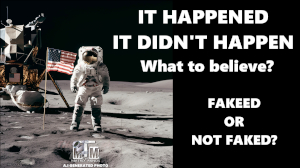 The Apollo moon landings have been hailed as a significant milestone in human history, showcasing the remarkable achievements of science and technology. However, despite overwhelming evidence supporting the moon landings, a persistent debate persists regarding their authenticity. Some proponents of conspiracy theories argue that humans never set foot on the moon, while others find connections in ancient texts or propose alternative explanations, such as the glass ceiling theory. In this article, we will explore these speculations and invite readers to consider the question: What do you believe?
The Apollo moon landings have been hailed as a significant milestone in human history, showcasing the remarkable achievements of science and technology. However, despite overwhelming evidence supporting the moon landings, a persistent debate persists regarding their authenticity. Some proponents of conspiracy theories argue that humans never set foot on the moon, while others find connections in ancient texts or propose alternative explanations, such as the glass ceiling theory. In this article, we will explore these speculations and invite readers to consider the question: What do you believe?
The Moon Landing Controversy
The idea that the moon landings were a hoax emerged shortly after the Apollo 11 mission in 1969. Conspiracy theorists claim that the United States government, motivated by the Space Race against the Soviet Union, staged the entire event to maintain a facade of superiority. They point to alleged inconsistencies in the photographs, shadows, and flag movements as evidence of the deception.
Scientific evidence, however, overwhelmingly supports the moon landings. Independent investigations, such as laser-ranging experiments that measure the distance between Earth and retro-reflectors left on the moon’s surface, have confirmed the presence of humans on the lunar landscape. Additionally, the Apollo missions brought back significant amounts of moon rock, the authenticity of which has been verified by countless scientists.
Biblical References
Some conspiracy theorists seek to connect the moon landing controversy to religious texts, such as the Bible. They claim that certain passages offer hints or veiled references to the idea that humans have never set foot on the moon. However, it is essential to note that the Bible was not intended to be a scientific or historical document but rather a spiritual guide for believers.
Interpreting biblical texts to support moon landing conspiracy theories requires a significant stretch of imagination. The passages that some proponents cite, such as Joshua 10:13 and Psalms 72:5, refer to miraculous events involving the sun and the moon. These accounts are best understood within their historical and cultural contexts, rather than as direct references to a lunar landing hoax.
The Glass Ceiling Theory
Another alternative theory proposed by some conspiracy theorists is the “glass ceiling theory.” According to this idea, the moon is surrounded by an impenetrable barrier or “glass ceiling” that prevents human exploration. Proponents of this theory claim that governments and space agencies perpetuate the myth of moon landings to conceal this barrier from the general public.
However, the scientific community widely dismisses the glass ceiling theory as lacking evidence and contradicting established scientific knowledge. Observations from telescopes, satellites, and spacecraft missions have provided detailed images and data about the moon’s surface, geology, and composition. These findings indicate no physical barrier impeding human access to the moon.
What Do You Believe?
As with any conspiracy theory, it is essential to approach the moon landing controversy with critical thinking, skepticism, and reliance on evidence-based facts. While speculation and alternative theories can be intriguing, the scientific consensus overwhelmingly supports the reality of human moon landings.
Beliefs are subjective, and individuals may form their own opinions on the matter. However, it is crucial to evaluate the evidence available from credible scientific sources and consider the broader scientific consensus.
The speculation surrounding the authenticity of the moon landings continues to capture the imagination of individuals across the globe. While conspiracy theories and alternative explanations may seem compelling to some, the overwhelming scientific evidence supports the reality of human exploration on the moon. As we navigate discussions about the moon landing controversy, it is crucial to base our beliefs on reliable evidence and remain open to critical analysis and scientific consensus.
WEEKLY POLL




Leave a Reply
Want to join the discussion?Feel free to contribute!